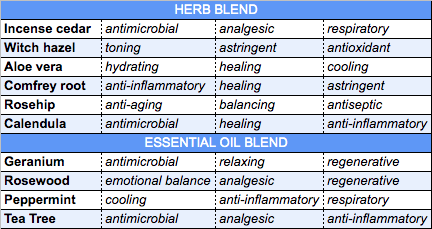Mindful Mist Benefits
Ingredients: We make our own *cedar floral water (a.k.a. hydrosol or hydroflorates) by steam distilling local incense cedar (Calocedrus decurrens). We add handcraft rosehip (Rosa ssp.), comfrey (Symphytum officinale), and calendula (Calendula officinalis) extracts and combine them with healing aloe (Aloe vera) and hydrating vegetable glycerin with skin toning witch hazel (Hamamelis virginiana) and willow bark (Salix alba) extracts. The floral blend of energy clearing geranium and rosewood, with energizing peppermint and tea tree is a divine combination to help you find your happy place.
FULL RESEARCH
Incense-cedar
Incense-cedar - Cypress family (Calocedrus decurrens - Cuppresaceae)
We make our own *cedar floral water (a.k.a. hydrosol or hydroflorates) by steam distilling local incense cedar. This aromatic California native grows in Sierra Nevadas at elevations up to 7,000 feet. Like many coniferous trees, incense-cedar is known to have astringent, antiseptic, antispasmodic, antioxidant, anti-inflammatory, tonic, and antimicrobial activities on the skin. In alternative medicine, incense-cedar is used for coughs and colds, congestion, as a disinfectant, stimulant, and for muscle pain. Native Americans used incense-cedar as a steam bath or inhalant for colds. Today the therapeutic benefits are attributed to the bioactive compounds pinene, myrcene, carene, limonene, and terpinolene.
Comfrey
Comfrey - Borage family (Symphytum officinale - Boraginaceae)
Comfrey comes from the Latin word confirma, meaning to heal or unite. By no accident, this root is a true powerhouse for skin ailments. Consistent studies indicate comfrey to be useful for anything from bruises and sunburns to insect bites and sprains, strains, and swellings, or the pain that comes with these common human happenings. One of the bioactive compounds in comfrey is allantoin, a compound that speeds up the regeneration of damaged tissue. Other compounds include carotene, asparagine & mucilage (healing), tannin (astringent), rosmarinic acid (antioxidant), alkaloids, and inulin. Together these compounds promote anti-inflammatory, antiseptic, astringent, emollient, tonic, and vulnerary (wound healing) actions when used topically. Actually, comfrey is so easy to grow, it can easily become invasive if grown in a home garden.
Calendula
Calendula - Daisy family (Calendula officinalis - Asteraceae)
Calendula is a bright yellow flower native to the Mediterranean countries. It was first brought to America by colonists who used this herb for protection. Now it is one of the most common and widespread medicinal plants around the world. The petals are edible and can be added to salads for a color pop with some useful therapeutic benefits. When cooked and added to rice or similar foods, it is known to change the pigment toward yellow. The flower has a wide range of therapeutic uses both internally and topically.
In Ayurvedic medicine, calendula is cooling, bitter, and pungent. In Traditional Chinese Medicine, the flower is neutral and drying. Calendula is associated with the sun and fire element. Historically, calendula was used as an astringent and anti-inflammatory agent integrated similarly to saffron (the most expensive spice in the world). Calendula was used to increase perspiration (fever & flu), to treat jaundice (liver dysfunction), stomach ulcers, during menses, inflammatory eye and skin conditions (wounds, sores, burns, cuts, minor infection, etc.). Calendula was ornamentally and strategically placed to ward off evil energy and infectious disease. The pigment was used for products, from clothing dye to cheese.
Since the 80s, calendula has shown to be beneficial on tissue regeneration and epithelial tissue development. Today, triterpenes are applauded for anti-inflammatory capabilities. The European Union has declared that calendula flower has oromucosal and cutaneous benefits with anti-inflammatory, astringent, immuno-stimulant, antiviral, antibacterial, anti-fungal, and vulnerary actions.
Rosehip
Rosehip - Rose family (Rosa ssp. - Rosaceae)
Rosehips are established as well-known as an anti-aging, skin healer. Aging can be attributed to time, lifestyle choices, and excessive UV exposure. With antiseptic, antimicrobial, and antioxidative properties, rosehips hydrate skin, regulate oil, are healing for hyperpigmentation, inflammation, skin blemishes, and scarring. Hydrophilic compounds such as ascorbic acid, fatty acids, quercetin, kaempferol, flavonoids, vitamin C, and other polyphenolic compounds have demonstrated strong antioxidant activity, reducing tissue damage. Recent research has shown rosehip to be beneficial for painful conditions.
Aloe
Aloe - Succulent family (Aloe vera - Asphodelaceae)
Aloe has been shown to supply moisture directly to tissues and produce a relaxing and cooling effect, making it the most sought after herb for sunburns and skin healing. Aloe grows in hot, dry climates like cactuses and succulents. In the United States, aloe is cultivated in Florida, Texas, and Arizona. Aloe has hydrating, softening, healing, antimicrobial, and anti-inflammatory properties for a variety of skin conditions. Aloe has been shown to supply moisture directly to tissues and produce a relaxing and cooling effect.
Witch hazel
Witch hazel - Witch hazel family (Hamamelis virginiana - Hamamelidaceae)
Witch hazel, the hydrosol extract of the (Hamamelis virginiana) plant, can be found in just about any market thanks to the FDA approval as an over-the-counter astringent. Witch hazel is a shrub/small tree native to the East Coast of America that has been used as an astringent due to the high tannin content to treat inflammation and swelling. Witch hazel is approved for minor skin injuries, bruises, and sprains. Since the 90s, witch hazel has been shown to be effective against sunburns and inflammation caused by UV-damage. Witch hazel leaf contains tannins, antioxidants, flavonoids, and essential oils and is most commonly used as a face toner.
Willow bark
Willow bark - Willow family (Salix alba - Salicaceae)
The medicinal uses of willow bark have their origins in Greek medicine. In the Middle Ages, this shrub was used to reduce fevers, relieve pain, and inflammation. In the 1800s, glycosidic compounds and salicylates were identified as the catalysts for the potent benefits. In fact, salicylic acid was first found in meadowsweet, then used to derive the popular drug, aspirin. Today, willow bark is used as an antioxidant, tonic, and astringent for a variety of dermal conditions.
Mindful Mist is the perfect botanical remedy to add to your breathwork, meditation, yoga practice, or workout. Spray directly on to your face, body, or around your space to utilize this healing, energizing, and centering remedy. With antimicrobial, toning, antioxidant, and regenerative herbal powerhouses for skincare, mixed with cooling and relaxing floral aromatherapy, you can heal your skin and ease your mind with one spray. Science shows antimicrobial, toning, antioxidant, regenerative, relieving, healing, cooling, and relaxing properties of the flowers and plants in the formula.
References
American Botanical Council. (2000). Herbal Medicine Expanded Commission E: Witch Hazel Leaf & Bark.
American Botanical Council. (2000). Herbal Medicine Expanded Commission E: Willow Bark.
American College of Healthcare Sciences. (2018). Comfrey Monograph.
Cohen, M. (2012). Rosehip: An evidence based herbal medicine for inflammation and arthritis. Australian Family Physician.
Essential Oil and Aromatherapy Experts. (2020). Rosehip benefits, uses for face, skin, hair, and where to buy.
European Medicines Agency. (2018). European Union Herbal Monograph on Calendula officinalis L., flos.
Garcia, G., Tissandié, L., Filippi, J., & Tomi, F. (2017). New Pinane Derivatives Found in Essential Oils of Calocedrus decurrens. Molecules (Basel, Switzerland), 22(6), 921.
Ibrahim, T. A., El-Hela, A. A., El-Hefnawy, H. M., Al-Taweel, A. M., & Perveen, S. (2017). Chemical composition and antimicrobial activities of essential oils of some coniferous plants cultivated in Egypt. Iranian journal of pharmaceutical research : IJPR, 16(1), 328–337
Marmol, I., Sanchez-de-Diego, C., Jimenez-Moreno, N. Ancin-Azpilicueta, C. Rodriguez-Yoldi, M. (2017). Therapeutic applications of rosehips from different Rosa species. International Journal of Molecular Sciences. 18(6), 1137
Michalun, N., & Michalun, M. (2001). Skincare & Cosmetic Ingredients Dictionary 2nd Ed. Thomas Learning. ISBN:1562636605
Native American Ethnobotanical Database. (2020). Incense-cedar (Calocedrus decurrens).
Natural Medicines Database. (2020). Aloe.
Ulbricht, C. (2010). Natural Standard: Herb and Supplement Guide. Mosby : Elsevier. ISBN 978-0-323-07295-3
U.S. Forest Service. (2015). Calocedrus decurrens: Fire effects information system (FEIS).



